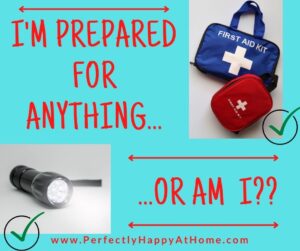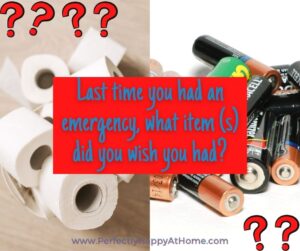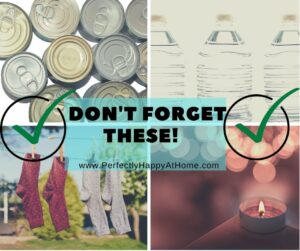 Preparation. Preparing. Some people call it “prepping.” Whatever you call it, it’s important in almost everything you’ll ever do in life, right? Test, job interview, or promotion coming up? Gotta gather materials and study them prior to the date to be prepared! Making a cake? Gotta buy the ingredients beforehand in order to be prepared! Going on a trip? Gotta pack everything ahead of time so that you’re prepared! Did you catch all the refences to being ready for something before it actually happens? Being prepared for things is just necessary for life. Sometimes, though, we forget that there are other things to be prepared for that we maybe don’t think about all the time, but could be life or death for us or for our family.
Preparation. Preparing. Some people call it “prepping.” Whatever you call it, it’s important in almost everything you’ll ever do in life, right? Test, job interview, or promotion coming up? Gotta gather materials and study them prior to the date to be prepared! Making a cake? Gotta buy the ingredients beforehand in order to be prepared! Going on a trip? Gotta pack everything ahead of time so that you’re prepared! Did you catch all the refences to being ready for something before it actually happens? Being prepared for things is just necessary for life. Sometimes, though, we forget that there are other things to be prepared for that we maybe don’t think about all the time, but could be life or death for us or for our family.
Something I have always been super passionate about is being prepared for emergencies. This is something that was ingrained in me as a young child in elementary school. I grew up in California, land of earthquakes and other catastrophes. We practiced, as they still do, earthquake/emergency drills, and even had earthquake kits in our classrooms. We also had the classic fire drills everyone else has, too. I took this stuff to heart as a young kid. I already knew at that point that I wanted to be a teacher and a mom, so I realized that what I was learning about emergency preparedness was valuable.
One of the first things I did when we got married was to make an emergency kit for our home. As a teacher, I kept an extensive emergency kit in my classroom, like all the other teachers at my school did. I keep a small emergency kit in my car. In recent times, I have expanded out home emergency kit to to boxes instead of one. When the whole “2020” year hit, and shelves were emptied, toilet paper became a tool for bartering, and even batteries were scarce, I learned some valuable lessons. I had thought we were pretty prepared at our house, but I quickly found out that we were not nearly as ready as I had thought. When I assemble our emergency kit, I try to imagine different circumstances under which we might need to use the kit, so I can make sure to include important and useful items for each scenario.
Now that it’s “monsoon season” (my favorite!) here in my home state of Arizona, it’s time for me to do my annual inventory check of our emergency supplies. It’s a really great idea to do this type of check once a year, just so that if things need to be replaced, rotated out, etc, you have a chance to do that. For us, the most likely danger we face during our monsoon season is power outage. I make sure to add flashlights, batteries, candles, lighters, and matches to the kit. HELPFUL HINT: Store the batteries in their original packaging, not inside the flashlights to prevent corrosion and damage to the flashlights.
Now I bet you’re wondering by now what else I put into our home emergency kit! I’ve compiled a list for you, so that you can use it to jumpstart your own list tailored to your location and needs.
HOME EMERGENCY KIT
- candles
- matches and lighters
- flashlights with batteries
- dry socks for each family member
- flip-flop type sandals for each family member (try dollar stores for these!)
- extra leashes, bowls, and food for the dogs
- heavy duty trash bags
- duct tape, electrical tape, masking tape
- solar blankets (one per family member)
- toilet paper (one roll per person)
- first aid kit (a large one with everything in!!!!)
- basic tools: hammer, nails, pliers, screwdrivers, box cutter, rope, twine, scissors
- can opener
- canned food (shelf stable for at least one year/an assortment of proteins and carbohydrates)
- tarps
- rain ponchos for each person
- nitrile gloves
- heavy duty work gloves
- cooking pots, kettle (think cooking over a campfire…check out this set I found)
- instant coffee
- bottled water (I pack one 6-pack per person)
- plastic grocery bags
- medicines such as acetaminophen, ibuprofen, cough drops, antihistamines for allergic reactions, and any prescription meds needed (Please BE SAFE, and keep all medicines in a child proof container!!!!)
- small towels, wet wipes, wash cloths
- bar soap, dish soap
- paper plates, plastic utensils, cooking spoon (or consider a mess kit for each person)
- face masks, bandanas (for blocking smoke, etc.)
- clean T-shirt for each family member
- toothbrushes and toothpaste
- small sewing kit
- super glue
- tweezers
- eye protective goggles (for falling ash), eye drops, extra prescription eyeglasses if needed
- copies of important documents you might need
- playing cards, chewing gum, mints, pens/pencils, paper, small games such as crossword puzzles (Always include items to bring joy and relieve tension, while bringing some normalcy to a prolonged emergency situation.)
 Phew! I know, that’s a lot of items! I pack ours strategically in two large plastic bins with lids. Where you store these bins depends on your situation. You will want to place them in a spot that can be easily and safely reached in 30-60 seconds during an emergency situation. I like the plastic bins because they are stackable, and they can readily be loaded into a vehicle if we need to leave in a hurry. Again, my family’s list of emergency items needed might be different that the list you compile for your family, because we may live in different places with unique natural disaster risks. I hope my preparedness ideas have sparked some ideas for you! May you be blessed never to have cause to use your emergency kit, but also blessed to have it ready if you need it. Sending love and joy your way today!
Phew! I know, that’s a lot of items! I pack ours strategically in two large plastic bins with lids. Where you store these bins depends on your situation. You will want to place them in a spot that can be easily and safely reached in 30-60 seconds during an emergency situation. I like the plastic bins because they are stackable, and they can readily be loaded into a vehicle if we need to leave in a hurry. Again, my family’s list of emergency items needed might be different that the list you compile for your family, because we may live in different places with unique natural disaster risks. I hope my preparedness ideas have sparked some ideas for you! May you be blessed never to have cause to use your emergency kit, but also blessed to have it ready if you need it. Sending love and joy your way today!
